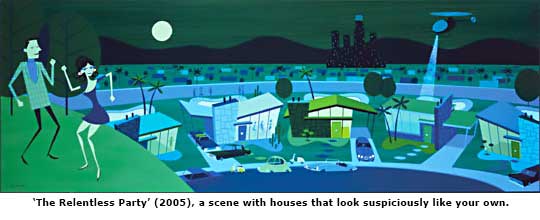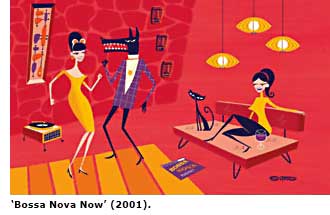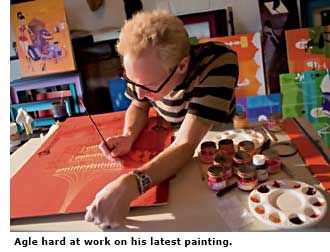Mid-Century Modern Art: Shag's World


Pretend you're the new owner of a lovely mid-century modern home—post-and-beam, open plan, walls of glass, sleek and stylish, and devoid of furnishings.
Start shopping!
An Eames leather chair or two—check. An amoeba-like Noguchi glass table? Natch. A George Nelson clock—of course. So Space Age!
But how about those walls! A picture would look nice. Something sophisticated and svelte: a heavy-lidded blonde, say, in a skin-tight cocktail dress, reclining on a divan. Or a James Bond-like figure enjoying cocktails—in a house that looks suspiciously like your own.
The artist to choose? Who else but Shag.
In Eichler homes throughout Northern California, in Alexanders in sunny Palm Springs, in modest Streng Bros. half-plexes in the Sacramento Valley, and even in luxurious modern masterpieces designed by Los Angeles architects John Lautner and Ray Kappe, paintings by Shag have become as integral to the decor as flat-screen TVs.
Shag—the nom de brush for the artist known to friends as Josh Agle—remembers going on a home tour of an Eichler neighborhood in the city of Orange. "At least 50 percent of the homes had my prints in them," he says.
"For some reason," he says of his artwork, "it does seem to look good in modern houses."
In fact, the reason is obvious. Nothing on canvas looks more '50s or early '60s—or at least the early 21st century vision of the '50s and '60s—than paintings by Shag—not even stuff that really was painted back then.
Beatniks playing bongos, Tiki lovers sipping cocktails, jazz artists playing it cool, even a grizzly bear grabbing a trout from the swimming pool of a butterfly-roofed home—Shag paints the era not as it was, but as a dream that may still come true.
And no artist has ridden the mid-century modern wave with more skill than Shag.

"My career as an artist came along with people's interest in mid-century modern architecture and furniture," Agle says, surrounded by Tikis, his own paintings, paintings by his friends, and artwork by some actual 1950s artists who influenced him, in the studio of his mid-century modern home near Santa Ana in Orange County. "As people's appreciation of it grew, their appreciation of my art grew along with it."
"When I first started painting, there weren't that many people who were into mid-century modern," he says.
Shag hit at the right time, says Billy Shire, who's considered one of the inventors of so-called 'lowbrow art,' through his Los Angeles gallery La Luz de Jesus, which gave Shag his first one-man show in 1996. It sold out.

"It was a time when the economy was right—and the collector base that was forming, and that was desirous of the mid-'50s, was just coming into its own financially," Shire says. "And the Internet helped. A lot more people saw his work."
Not everyone whose mid-century modern home contains a Shag bought the painting to fit the house. "Some people bought mid-century modern houses because they liked my art," Agle says. And, he says, "Most of the people collecting my art don't even care about the '50s or '60s."
Today, although many artists work in styles rooted in the 1950s and early '60s (Shag estimates that six or seven are at it seriously, followed by "hundreds and hundreds of imitators"), few do it as successfully as Shag, Shire says.
"I was the first to stumble into this formula," Agle says.
He loved the work of such great 1950s illustrators and commercial artists as Gene Deitch and Jim Flora, both known for sophisticated, at times surrealistic cartoon-like album covers; and Charley Harper, known for highly stylized book illustration.

"I wanted to take that style and put it in a painting in a gallery, not just use it for commercial purposes," Agle says. "I had to do a few things for this. I decided, almost everything I painted would be telling a story. There would be several unexpected elements in the artwork, and there would be an ironic humor that you wouldn't find in the commercial art of the 1950s."
Shag's version of '50s art won fans quickly.




